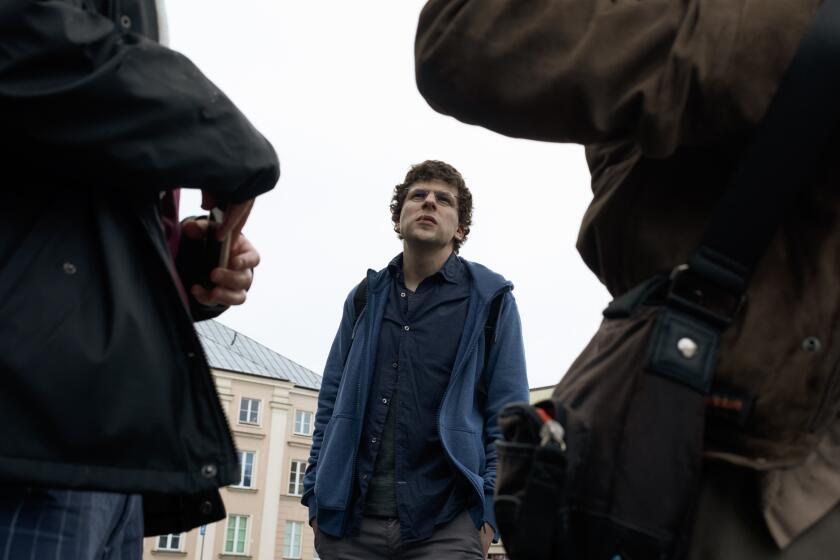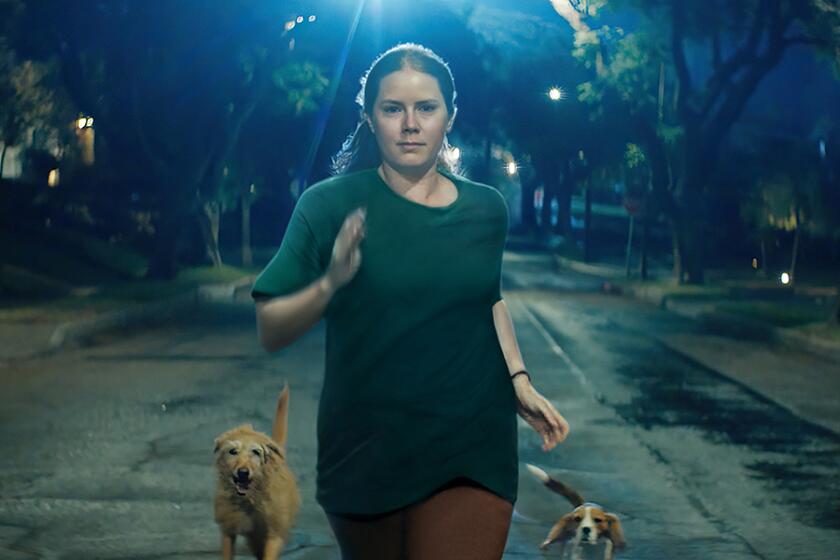‘The Wave’ director sought to make a fiord-disaster movie with heart
It arrives as a singularly Scandinavian cinematic offering that until last year had somehow never materialized on theater screens: the fiord disaster movie.
Inspired by epic-scale catastrophe classics — “Twister” and “Armageddon” among them — as well as real-life historical events, director Roar Uthaug set out to make “The Wave,” a disaster thriller that became a blockbuster in his native Norway and created a sensation upon its premiere at the Toronto International Film Festival in 2015.
See more of Entertainment’s top stories on Facebook >>
Wrapping white-knuckle spectacle around a Spielberg-esque domestic drama, the $6-million film, which opens Friday, follows a simple premise: What if an avalanche dumped millions of tons of rock into a fiord, triggering a tsunami? Given just 10 minutes’ warning, how would people living around an idyllic inlet escape cataclysmic destruction?
“I grew up watching Hollywood disaster movies and I think we, as European filmmakers, have a lot to learn from Hollywood,” Uthaug, 42, said by phone from Oslo. “I wanted to take the genre of a disaster movie and set that in something familiar to us Norwegians. The fact that these events have happened here before — and will happen here in the future — it was a great starting-off point.”
Until his longtime producing partner passed the director a newspaper article about the phenomenon, however, Uthaug admits he gave little thought to Norway’s unusual topography — or its narrative potential. With more than 300 unstable mountainsides and nearly 1,200 fiords, geologists believe the kind of ruination so vividly rendered in “The Wave” is close to inevitable.
Moreover, rockslide tsunamis have struck the country several times before; in 1934, the town of Tafjord was devastated by such an event that killed 40 people. And as recently as 2014, a tsunami hitting the tiny hamlet Nord-Statland forced evacuations and resulted in widespread property damage. “For most Norwegians, it’s not something you’re aware of,” said Uthaug, who consulted with geologists, historians, search-and-rescue responders and tsunami experts during pre-production.
“The Wave” follows Kristian (Kristoffer Joner), an earthquake specialist at an emergency early-warning detection center, who’s in the process of moving his preemptively homesick tween-age daughter and emo skateboarder son away from the postcard-perfect tourist town Geiranger to the city for a prestigious corporate job. His wife, Idun (Ane Dahl Torp), meanwhile, works the late shift at a hotel in town.
But after off-the-chart seismic readings prompt Kristian to push the panic button — thereby sending the local populace scrambling for higher ground — he must race against the clock to reunite his family or condemn them all to a watery grave.
To hear it from Torp, a popular film and TV actress in Norway, Uthaug’s emphasis was always on fleshing out a human story at the center of the action. “We were watching dailies on the monitor, showing the happy family in the beginning of the film,” she recalled. “And I watched his eyes cracking, turning red. Then he said with utter delight and anticipation, ‘Ooh, it’s so painful to know all the horrors they will be exposed to in a little while!’ That proved to me not only how much Roar loved the characters in his film but also his true instincts for his genre.”
For many industry observers, though, the movie’s price tag is nearly as eye-popping as the 80-meter-high wall of water seen rampaging between steep mountains in “The Wave.” Thanks to strict financial discipline that belies its production values, Uthaug kept costs almost shockingly low. That included a variety of computer-generated shots of big-wave destruction that wouldn’t look out of place in a Roland Emmerich’s disaster-porn filmography as well as weeks of production in Bucharest, Romania, for a terrifying sequence in the submerged hotel. There, 40,000-liter “tip tanks” flooded the sets with water. And the actors, who trained with diving instructors before production, performed their own stunts.
“Before we started shooting I was terrified,” said Torp, who learned to hold her breath for up to three minutes for the shoot. “Being wet and in water 12 hours a day for two weeks was totally exhausting. I talked to my husband on Skype every day, and he thought I was drunk because I was so torn up every night.”
For his part, Uthaug remains uncontrite about what he put the actors through: “It helped. It added that tension to the scenes — the reality we were looking for.”
Named one of Variety magazine’s “10 European Directors to Watch” in 2013, Uthaug began making films in eighth grade and received his degree from the Norwegian Film School in Lillehammer. His films have spanned the cultural spectrum: from children’s fantasy (“Magic Silver,” 2009) to slasher-horror (“Cold Prey,” 2006) to medieval thriller (“Escape,” 2012) to, now, Nordic catastrophe drama.
And since breaking away from the kind of minutely observed art-house dramas that have defined most Norwegian cinematic output to date, the director remains agnostic about using genre in the service of good, old fashioned storytelling. “What I’m after is engaging the audience and finding characters I care about,” Uthaug said. “I’m just interested in taking the audience on an emotional roller-coaster ride. If that’s through action or disaster or sci-fi, I’m open.”
Perhaps unsurprisingly, Hollywood began blowing up his phone after “The Wave” received critical hosannas in Toronto and was chosen to represent Norway in the Academy Awards’ foreign-language film category. In November, co-distributors MGM and Warner Bros. hired Uthaug to direct a reboot of the video game movie adaptation “Tomb Raider.”
Two installments of the shoot-’em-up travelogue starring Angelina Jolie as the titular British archaeologist — “Lara Croft: Tomb Raider” (2001) and 2003’s “Lara Croft Tomb Raider: The Cradle of Life” — combined to gross $421 million. While the soft-spoken Uthaug is excited to put his mark on the franchise in his first non-Norwegian film, he refuses to divulge details about the project. Except, that is, to place Lara Croft within a continuum of strong female characters in blockbuster action-adventure movies that includes Katniss Everdeen in “The Hunger Games” movies, Tris Prior in “The Divergent Series” and Black Widow in the Marvel Cinematic Universe.
“She was one of the characters who started it all,” Uthaug says of Croft. “So I’m very proud to be a part of this.”
Likewise, he is proud to have exploded the scope of what Norwegian cinema can be — even if that has meant putting forward the idea of his homeland as a place of impending fiord destruction. “Hopefully it won’t keep people from coming here,” he said with a short laugh. “It hasn’t kept Norwegian people from living in those areas.”
More to Read
Only good movies
Get the Indie Focus newsletter, Mark Olsen's weekly guide to the world of cinema.
You may occasionally receive promotional content from the Los Angeles Times.











